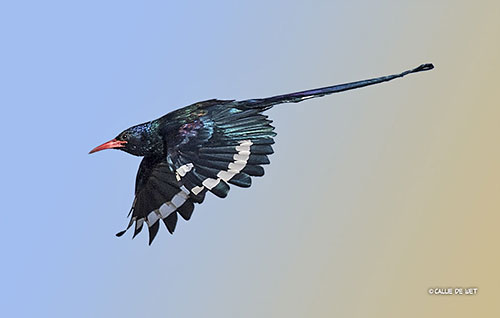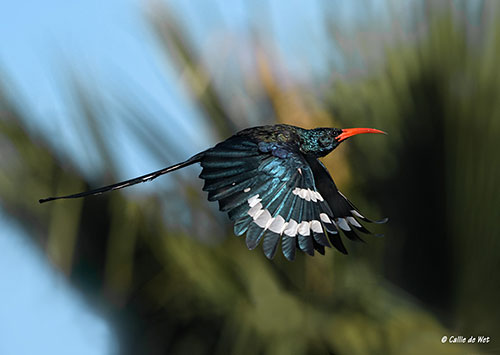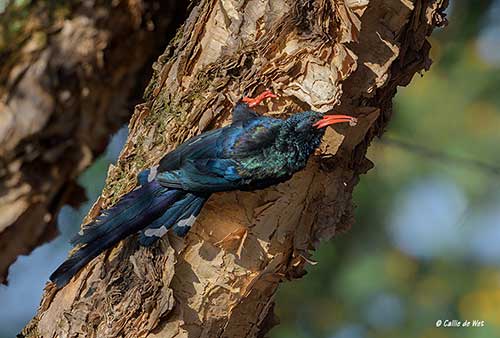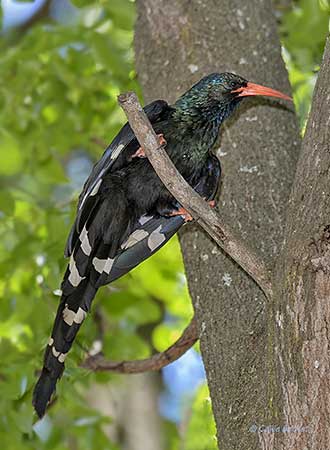
Fr: Irrisor moqueur
Ang: Green Wood Hoopoe
All: Baumhopf
Esp: Abubilla arbórea verde
Ita: Upupa boschereccia verde
Nd: Groene Kakelaar
Sd: grön skratthärfågel
Photographers:
Callie de Wet
GALLERY
Steve Garvie
RAINBIRDER Photo galleries & Flickr Rainbirder
Text by Nicole Bouglouan
Sources:
HANDBOOK OF THE BIRDS OF THE WORLD Vol 6 by Josep del Hoyo-Andrew Elliott-Jordi Sargatal - Lynx Edicions, 2001 - ISBN: 848733430X
BIRDS OF THE GAMBIA AND SENEGAL by Clive Barlow and Tim Wacher – Helm Field guides – ISBN: 0713675497
BIRDS OF AFRICA SOUTH OF THE SAHARA by Ian Sinclair and Peter Ryan - Princeton University Press Princeton and Oxford - ISBN: 0691118159
Birdlife Botswana – Bird of the Month – The Green Wood Hoopoe
Coraciiformes Taxon Advisory Group
ScienceBlogs - Hoopoes and Woodhoopoes
Territorial vocal rallying in the green woodhoopoe: influence of rival group size and composition
THE AVIANWEB - Beauty of Birds (Sibylle Faye)
Wikipedia, the free encyclopaedia
Green Wood Hoopoe
Phoeniculus purpureus
Bucerotiformes Order – Phoeniculidae Family
INTRODUCTION:
The Green Wood Hoopoe is a highly specialized bird that exploits a unique position in nature.
It feeds in cracks and crevices. The female forages on branches for small insects, whereas the male probes in deep crevices for larger prey. Male and female have different bill’s length and shape, and they feed separately. As this species usually lives in groups, this gender-related feeding behaviour avoids competition for food or feeding sites within the flock.
The group defends collectively and strongly its territory against other flocks. The territorial disputes are accompanied by loud, cackling calls and intimidating postures.
During the breeding season, co-operative breeding is usually common. The monogamous pair is helped by several members of the flock during the nesting period.
The Green Wood Hoopoe is widespread throughout the wide African range, and the species is not currently threatened.

DESCRIPTION OF THE BIRD:
Biometrics:
Length: 33-44 cm
Weight: M: 54-99 g – F: 52-75 g
The adult of nominate race has dark green plumage overall, with sheens of black, green, purple and blue. Head and throat are bluer, the nape is violet and the upper mantle is blue. On the upperwing, we can see a white wingbar across the middle of the primaries, whereas the primary coverts only have white tips. The long, graduated tail shows white subterminal spots.
The long, down-curved bill is red (size: 49-63 mm). The eyes are dark brown. The short legs and the strong feet are reddish.
The female has similar plumage, but she is smaller, with shorter bill than male (37-60 mm).
The juvenile has duller plumage. The bill is dark and straighter, and legs and feet are dark too. Most juveniles may have brown or buff throat and smaller white spots on the tail.

P.p. senegalensis
Juvenile
SUBSPECIES AND RANGE:
The Green Wood Hoopoe has six subspecies. These races are difficult to separate in the wild. The differences are based primarily on plumage sheen and extent of white on wings and tail. All the races are larger than nominate.
P.p. guineensis occurs in S Mauritania, N Senegal and Mali to N Ghana, Nigeria, S Chad and Central African Republic.
This race has more blue-green crown and face, shorter wings and longer tail.
P.p. senegalensis occurs in S Senegal and Gambia, E to S Ghana.
This one has duller crown, nape and mantle, the latter more violet. The bill is partly or completely black.
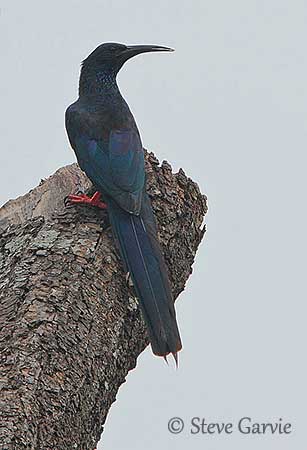
P.p. marwitzi occurs in Uganda and Kenya, S to NE South Africa, and there are some records in extreme S Somalia.
This race is iridescent, with blue face, chin, nape and crown, blue-green neck, green mantle, scapulars, throat and breast.
P.p. niloticus is found in S Sudan, W Ethiopia, South Sudan and NE DRCongo.
This race is duller and darker than “marwitzi”.
P.p. angolensis is found in Angola and Namibia, E to W Zambia and W Zimbabwe, and S to N South Africa.
This race has more extensive blue on nape and throat, and the white tail spots are larger than in nominate.
P.p. purpureus (described above) is found in SE South Africa, from E Western Cape to KwaZulu-Natal.
HABITAT:
The Green Wood Hoopoe occurs in a wide variety of woodlands, thickets and forest edges, but also in savanna, palm groves and wooded gardens, from near sea-level up to 2000 metres of elevation. It usually avoids arid areas and forest. They need primarily cavities for nesting and roosting.
CALLS AND SONGS: SOUNDS BY XENO-CANTO
The Green Wood Hoopoe is a noisy bird, and the vocalizations play an important role in the social life of this species. In addition, a single-note call allows to identify the sex of the bird. The male utters “kuk” calls when alarmed “kuk-uk-uk-uk” culminating in a frenzied choral cacophony. This “song” is also given during displays and territorial disputes. When alarmed, the females of the flock give higher-pitched “keek”.
During displays, (or “rallies”) within the group, we can hear prolonged chuckling and cackling vocalizations “kak-kak-kkkkk”. The calls given by each sex can be distinguished.
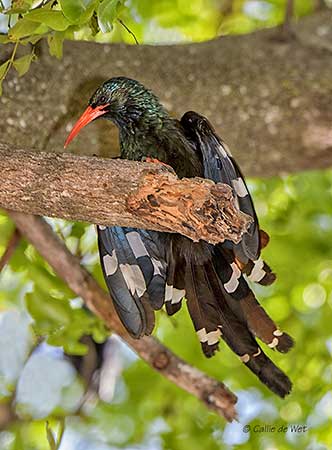
BEHAVIOUR IN THE WILD:
The Green Wood Hoopoe feeds primarily on arthropods, adults and larvae, including beetles, moths, butterflies, termites, bugs, grasshoppers, crickets, wasps, bees, ants, dragonflies and damselflies. It also consumes spiders and the eggs of spiders and insects. It also takes lizards in West Africa. Berries and Acacia seeds are eaten in addition of animal prey.
The Green Wood Hoopoe forages on trunks and branches, helped by its short legs and strong claws. It probes wood crevices and uses its strong bill to hammer flakes of bark from tree while searching for invertebrates.
It spends most of the day foraging in trees, but when the termites are swarming, it can become an excellent aerial insect-eater. The male may sometimes forage on the ground. These birds know how to make the most of every situation to find food.

P.p. senegalensis
Juvenile
The Green Wood Hoopoe is a gregarious species that lives in groups of 12-15 individuals. They perform social display known as “rally” during which the birds perch close together while rocking back and forth with half-extended wings, raising and depressing the long tail and uttering prolonged, loud “kuk-uk-uk-uk”.
These displays occur mainly during territorial encounters between other flocks, but also when the flock’s members are reunited. It is used to promote flock unity and cohesion, and especially during aggressive defence behaviour. Social behaviour takes a great place in their life.
Larger groups often dominate smaller ones, and a very small group of 2-3 birds cannot defend a territory if the neighbouring flocks are larger.
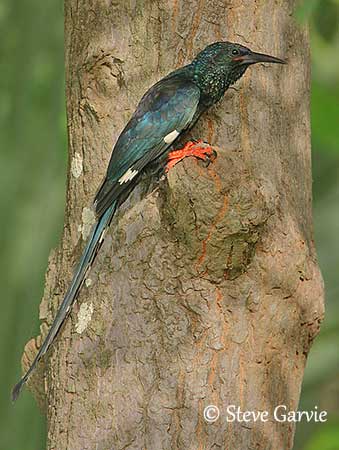
The Green Wood Hoopoe is monogamous. Within a flock, only alpha male and alpha female breed. The other members of the group assist in feeding the female during the incubation and the chicks during the nestling period.
Prior to nesting, both mates leave the group several times each day, in order to spend time perched together in or near the chosen nest-tree. They engage in mutual grooming and preening, and periodic copulation.
Before the egg-laying, the breeding female solicits food from all the flock members by producing an intense twittering. The nest-cavity is chosen by the female, usually close to good feeding sites.
The Green Wood Hoopoe is mostly resident, with only seasonal movements in West Africa. They often breed in territory in which they hatched. The nest-sites are also used for roosting all year round, and several birds roost together inside the cavity.
This species is able to discharge a foul-smelling glandular secretion if the birds are attacked. The regularly used roost-sites become quite smelly!
The Green Wood Hoopoe is often seen flying leisurely from tree to tree, but it is able to perform strong, swift flight for extended periods of time, especially when individuals or flocks engage in swirling aerial competition.

P.p. purpureus
Immature (Black bill)
REPRODUCTION OF THIS SPECIES:
The breeding season is often associated with rains in tropical regions, and over the wide range, breeding activity occurs throughout the year. There is usually one brood per year, but it food conditions are suitable, 2-3 broods can be produced.
The Green Wood Hoopoe is a co-operative breeder with helpers that take part in female and chick feeding.
They nest in tree cavity, but other sites such as roofs of houses can be used too. They do not build a nest, and sometimes, they remove the nest material placed in a cavity par other species, often woodpecker or barbet. The cavity is between 1 and more than 20 metres above the ground. The same cavity may be used several times.
The female lays 3-4 pale greenish-blue eggs with pale pits. The breeding female incubates alone during 17-18 days. She is fed by her mate and the members of the group. At hatching, the chicks have long white down growing from the feather tracts. They are completely helpless.
The female feeds them with the food brought at nest by both male and helpers. The young fledge 28-30 days after hatching. They can fly strongly 3-4 months after leaving the nest. They are still fed by the group for several weeks after fledging and they may remain with the flock for up to 5 years.
The usual nest predators are the African Harrier-Hawk and the Pearl-spotted Owlet.

P.p. purpureus
Immature (Black bill and duller plumage)
PROTECTION / THREATS / STATUS:
The Green Wood Hoopoe is common to locally abundant throughout the wide range, and in suitable habitat, usually large trees along watercourses.
This species can be found in several protected areas such as national parks. It may compete for nesting-sites with the Common Starling in urban areas.
Some declines are reported due to habitat destruction, but currently, the Green Wood Hoopoe is not globally threatened and evaluated as Least Concern.
